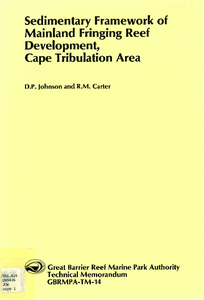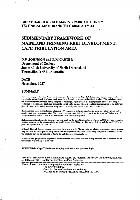Please use this identifier to cite or link to this item:
https://hdl.handle.net/11017/122

Full metadata record
| DC Field | Value | Language |
|---|---|---|
| dc.contributor.author | Johnson, D.P. | * |
| dc.contributor.author | Carter, R.M. | * |
| dc.coverage.spatial | Cape Tribulation | en |
| dc.date.accessioned | 2012-05-24T07:58:43Z | en |
| dc.date.available | 2012-05-24T07:58:43Z | en |
| dc.date.copyright | 1987 | en |
| dc.date.issued | 1987 | en-US |
| dc.identifier.isbn | 9780642120007 | en |
| dc.identifier.uri | https://hdl.handle.net/11017/122 | en |
| dc.description.abstract | Mainland fringing reefs with a diverse coral fauna have developed in the Cape Tribulation area primarily upon coastal sediment bodies such as beach shoals and creek mouth bars. Growth on steep rocky headlands is minor. The reefs have extensive sandy beaches to landward, and an irregular outer margin. Typically there is a raised platform of dead nef along the outer edge of the reef, and dead coral columns lie buried under the reef flat. Live coral growth is restricted to the outer reef slope. Seaward of the reefs is a narrow wedge of muddy, terrigenous sediment, which thins offshore. Beach, reef and inner shelf sediments all contain 50% terrigenous material, indicating the reefs have always grown under conditions of heavy terrigenous influx. The relatively shallow lower limit of coral growth (ca 6m below ADD) is typical of reef growth in turbid waters, where decreased light levels inhibit coral growth. Radiocarbon dating of material from surveyed sites confirms the age of the fossil coral columns as 33304110 ybp, indicating that they grew during the late postglacial sea-level high (ca 5500-6500 ybp). The former thriving reef-flat was killed by a post-5500 ybp sea-level fall of ca 1 m. Although this study has not assessed the community structure of the fringing reefs, nor whether changes are presently occurring, it is clear the corals present today on the fore-reef slope have always lived under heavy terrigenous influence, and that the fossil reef-flat can be explained as due to the mid-Holocene fall in sea-level. A medium term programme is required to record sediment loading and coral community structure, and to establish the environmental vulnerability of these reefs. | en |
| dc.language.iso | en | en |
| dc.publisher | Great Barrier Reef Marine Park Authority | en |
| dc.relation.ispartofseries | Technical memorandum TM-14. | en |
| dc.relation.ispartofseries | Technical memorandum series | - |
| dc.subject | Fringing reefs | en |
| dc.subject | Sediments | en |
| dc.subject | Cape Tribulation | en |
| dc.subject | Sea level variations | en |
| dc.subject | Coral reef and islands | en |
| dc.title | Sedimentary framework of mainland fringing reef development, Cape Tribulation Area | en |
| dc.type | Report | en |
| dc.subject.asfa | Fringing reefs | en |
| dc.subject.asfa | Sedimentary structures | en |
| dc.subject.asfa | Radiocarbon dating | en |
| dc.subject.asfa | Vulnerability | en |
| dc.format.pages | 40 | en |
| dc.contributor.corpauthor | Great Barrier Reef Marine Park Authority | en |
| dc.subject.apais | Scientific research | en |
| dc.subject.apais | Geology | en |
| dc.subject.apais | Environmental management | en |
| dc.publisher.place | Townsville | en |
| dc.relation.connectiontogbrmpa | GBRMPA published this item | en |
| dc.subject.category | Processes | en |
| dc.subject.category | Geographic features | en |
| dc.subject.category | Climate change | en |
| dc.subject.theme | Reef Ecosystems and Species | en |
| dc.subject.theme | Managing Multiple Use | en |
| dc.subject.location | Cairns/Cooktown Management Area | en |
| Appears in Collections: | Management | |
Files in This Item:
| File | Description | Size | Format | |
|---|---|---|---|---|
| Sedimentary-framework-of-mainland-fringing-reef-development-Cape-Tribulation-Area.PDF | main report | 3.66 MB | Adobe PDF |  View/Open |
Items in ELibrary are protected by copyright, with all rights reserved, unless otherwise indicated.
